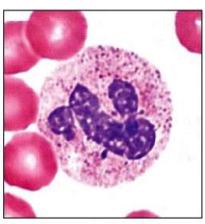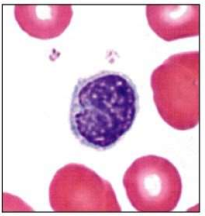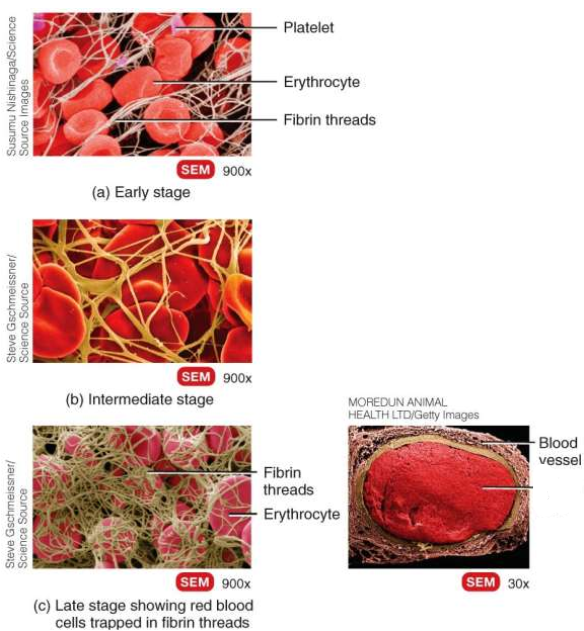-
What is the function of blood?
Transports oxygen, CO2, nutrients and hormones to and from the body's cells.
-
What is blood's regulatory function?
Regulates the body's pH and temperatures, and provides protection against disease through phagocytosis and the production of antibodies.
-
What does the plasma portion of blood consist of?
- water
- proteins
- other solutes
-
What does blood protect against?
Excessive loss of blood through clotting and WBCs to protect against infections.
-
Blood is thicker than water. True or false?
True; it has greater viscosity than water.
-
The percentage of total blood volume being occupied by RBCs is describing what?
The hematocrit
-
What is the normal hematocrit range for males and females?
Adult females: 38-46, the average is 42
Adult males: 40-54, the average is 47
-
Why do males have a higher hematocrit than females?
Because they have more testosterone and testosterone is a growth factor of ehrythropoietin.
-
A significant drop in hematocrit can indicate what?
Anemia because lower hematocrit means lower-than-normal RBCs.
-
What is polycythemia?
Percentage of RBC is abnormally high, thus higher-than-normal hematocrit.
-
Why is water so important to blood?
Because it's a solvent and suspending medium (gathers and carries it around). It can absorb, transport and release heat.
-
Plasma proteins are mostly produced by what organ?
The liver
-
What is the main function of plasma proteins?
They are major contributors to blood viscosity and the transportation of hormones (steroids), fatty acids and calcium.
-
Fibrinogen is a protein that does what?
Major contributor to blood clotting.
-
What type of stem cells differentiate into each of the different types of blood cells?
Pluripotent (pluri - many, a lot; potent - power (to differentiate into different cells)) stem cells
-
What are eosinophils, basophils and neutrophils preceded by?
Myeloblasts
-
What are some growth factors of hemopoiesis?
- erythropoietin; increases the number of RBC precursors
- thrombopoieting; ^ the number of platelet precursors
- cytokines; ^ the number of WBC precursors
-
What are the RBCs shaped as?

Biconcave discs
-
How are RBCs able to squeeze through capillaries?
Through their strong and flexible plasma membrane.
-
RBCs have a nucleus and other organelles. True or false?
False; they lack a nucleus and other organelles as they cannot reproduce or carry on extensive metabolic activities (aerobic respiration).
-
How are RBCs specialized for transportation of oxygen?
- Their shape allows a large SA for gas diffusion.
- Their lack of nuclei and other organelles allows all their internal space to be used for oxygen transport.
- Because they lack mitochondria and can generate ATP anaerobically, they don't use up any of the oxygen they carry.
-
What is hemoglobin composed of?

globin - protein
iron with heme pigments - 4
-
Besides carrying oxygen, what is another function of hemoglobin?
Regulation of blood pressure:
High blood pressure constricts the RBCs (vasoconstriction), and to lower it, Nitric oxide (NO) is bound to hemoglobin which causes vasodilation and lowers blood pressure.
-
Why can RBCs only live up to 120 days?
Because of the wear and tear on their plasma membranes as they squeeze through bc.
-
Describe the life cycle of RBCs and how hemoglobin is recycled.
1. Worn-out RBCs are phagocytized by macrophages.
2. When the RBCs are spit out through exocytosis, the heme and globin are split apart.
3. Globin is further broken into amino acids, that will be used for protein synthesis later.
4. Iron in heme will be transported back to the red bone marrow, to undergo erythropoiesis.
5. Remaining heme will be made into bilirubin which becomes a component of bile.
-
What happens when a proerythroblast turns into a reticulocyte?
It ejects its nucleus, which causes the center of the reticulocyte to indent. Making the biconcave shape of RBCs.
-
What is the body saying if a person has a high reticulocyte count?
They may have anemia. Because of their lack of RBCs, the body may be trying to compensate by increasing the rate of erythropoiesis which shows up through the reticulocytes.
-
Name the two stimulus for erythropoiesis?
- hypoxia (deficiency in oxygen)
- testosterone
-
What is happening to the body when there is an increase in WBCs (leukocytosis)?
Likely a response to stress such as invading organisms or even strenuous exercise.
-
What are the two classifications of leukocytes?
- Granular; vesicles that appear when strained (like a bunch of dots)
- Agranular; containing no visible granules
-


-
What cell identity markers are available in the WBCs and other nucleated cells?
Major histocompatability antigens (complex) (MHC), which protrudes from their plasma membrane into the ECF.
-
Are the blood group antigens in RBCs the same as MHC antigens?
No, they are different and RBCs lack them.
-
The granular leukocytes are:
- neutrophils
- eosinophils
- basophils
-
Neutrophils or Polymorphonuclear neutrophils, polymorphs or polys/ PMNs account for how many of all WBCs?
60-70%
-
What colour are neutrophils?
pale-lilac
-

What WBC is this and what does it do?
Neutrophils; they accumulate at sites of infection and are the first line of defense.
-
Eosinophils account for ___ of all WBCs.
2-4%
-

What WBC is this and what does it do?
Eosinophils; stain orange-red, and fight against parasitic infections and combats the effects of histamine and phagocytizes antigens.
-
Basophils account for ___ of all WBCs.
05.-1%
-

What WBC is this and what does it do?
Basophils; intensify inflammation and is involved in allergic reactions by releasing histamine.
-
The agranular leukcytes are:
- lymphocytes
- monocytes
-
Lymphocytes account for ___ of all WBC.
20-25%
-

What WBC is this?
Lymphocytes
-

What WBC is this and what does it do?
Monocytes; emigrates to site and differentiates into macrophages to destroy antigens.
-
Monocytes account for ___ of all WBC.
3-8%
-
Virus often stay inside macrophages, however symptoms don't manifest because they stay inside. What is an example of this?
98% of people have Simplex herpes.
-
What is the general function of leukocytes?
To combat inflammation and infection.
-
How do WBCs leave the blood stream?
By emigration and collect at sites of pathogen invasion or inflammation.
-
WBCs being chemically attracted to sites of disease or injury is called ___.
chemotaxis
-
What is hemostasis and the steps involved?
It is the sequence of responses that stop bleeding:
1. Vascular spasm
2. Platelet plug formation
3. Blood clotting (coagulation)
-
What happens during vascular spasm?
The wall of the damaged blood vessel contract (through the small muscle) to stop bleeding and to make time for platelets to arrive.
-
What occurs during platelet plug formation?
Platelets clump around the damaged area to stop bleeding.
-
What network is a clot made of?
Fibrin (insoluble protein fibers)
-
What occurs during the intrinsic (common) pathway of blood clotting?
1. Formation of prothrombinase (prothrombin activator)
2. Prothrombin into thrombin
3. Soluble fibrinogen into insoluble fibrin.
-

What is happening in this picture?
Coagulation
-
What is ABO blood typing based on?
The presence or absence of specific antigens and antibodies on the plasma membrane of the erythrocytes.
-
Does Rh+ have an antigen or shows a lack of?
It shows the presence of an antigen in the plasma membrane.

